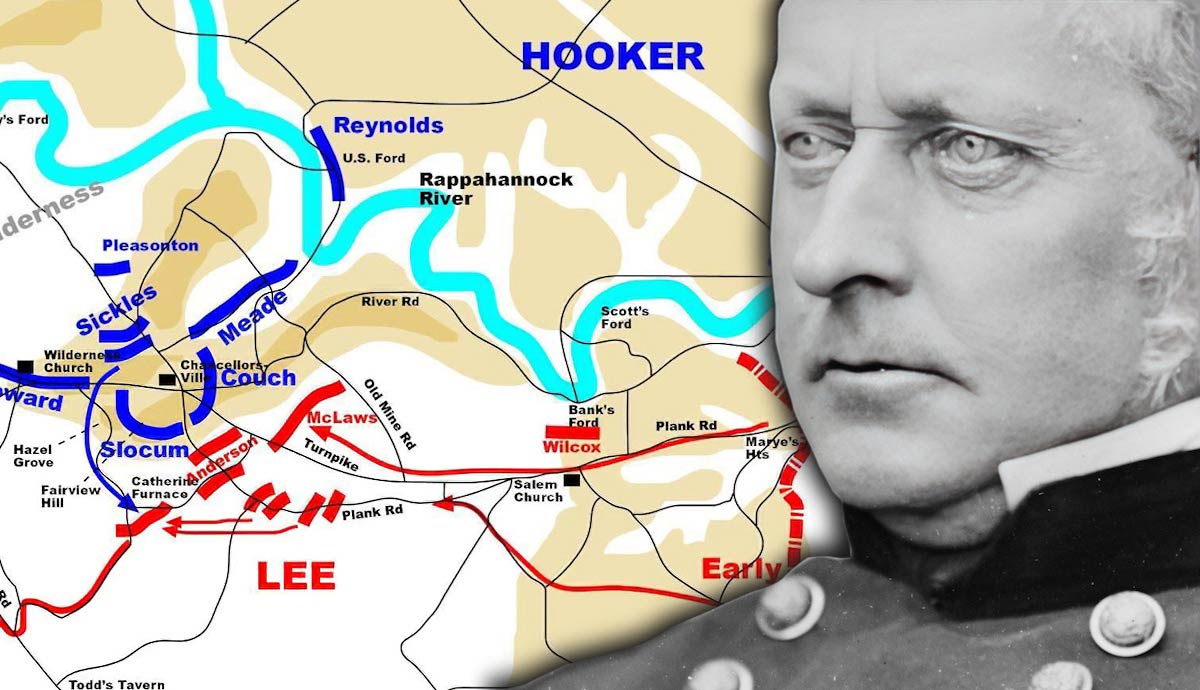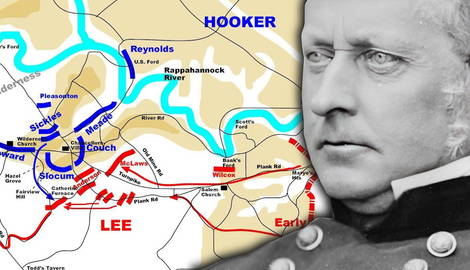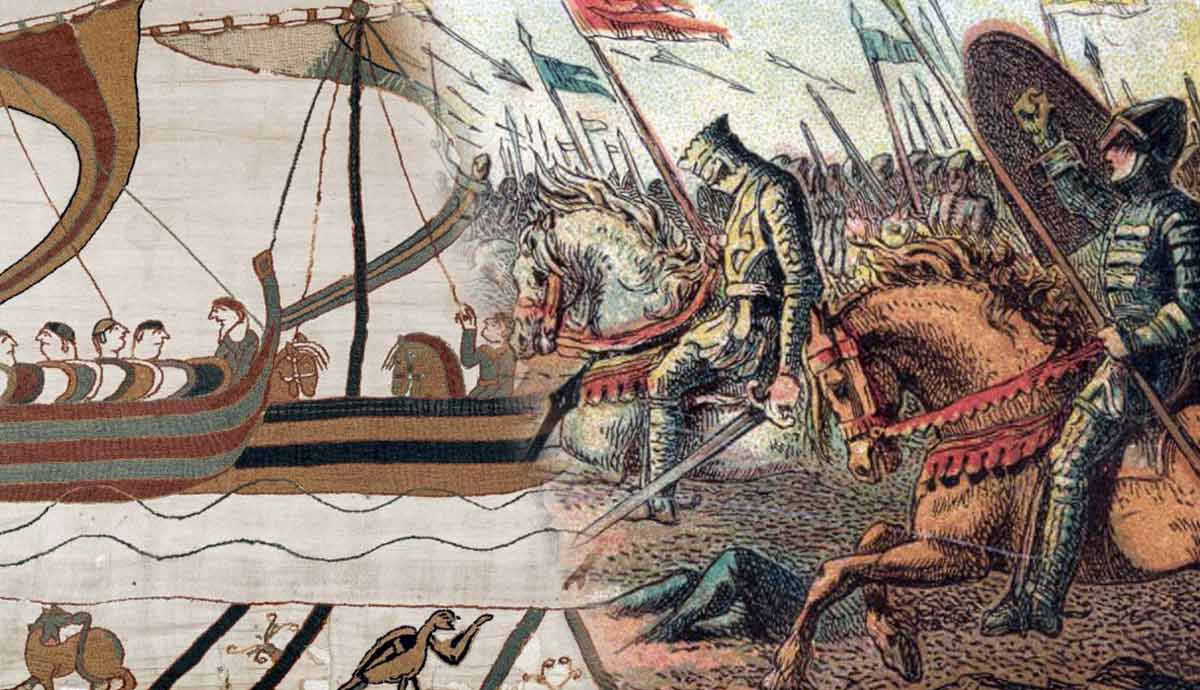
The US Civil War had bogged down into a stalemate in the Eastern Theater between the Union capital of Washington DC and the Confederate capital of Richmond, Virginia. Union President Abraham Lincoln realized that the quickest way to win the war was to defeat Confederate general Robert E. Lee, whose Army of Northern Virginia stood between those cities. A new Union general, Joseph Hooker, was given the task.
Victory Goes to the Confederacy

The Battle of Chancellorsville was a major victory for the Confederacy, which had spent most of the American Civil War (1861-65) on a defensive footing aside from the Battle of Antietam the previous autumn. Substantially outnumbered and vastly outproduced by the industrialized North, the South faced tremendous military challenges in holding out long enough for the Union to accept its secession. During 1862, the Union was able to reclaim chunks of the Confederacy, especially in the Western Theater, as well as New Orleans, the Confederacy’s most populous city. However, due to the geographic closeness of the Union and Confederate capital cities in the Eastern Theater, the South retained a chance at victory in the war if it could pressure Washington DC.
On June 1, 1862, skilled officer Robert E. Lee took control of the Confederate Army of Northern Virginia, pushing back Union troops from the Confederate capital of Richmond, Virginia in several battles. After Lee’s invasion of the North in September 1862, Union president Abraham Lincoln wanted action. General Joseph Hooker was given control of the Union Army of the Potomac and tasked with defeating Lee’s Army of Northern Virginia. Despite having an almost two-to-one advantage in manpower, Hooker was outmaneuvered by Lee in the six-day battle. Lee successfully split his forces multiple times, outflanking Hooker’s own attempts to outflank him. By May 6, 1863, Hooker had retreated back to Washington DC, suffering almost 4,000 more casualties than he had inflicted on Lee’s forces.
Timeline of the Battle of Chancellorsville

After months of planning his assault, Union General Joseph Hooker famously proclaimed, “May God have mercy on General Lee, for I will have none.”
On April 27, 1863, Hooker began his operation, hoping to march south quickly and maneuver his forces behind Robert E. Lee’s Army of Northern Virginia, cutting its supply lines.
On April 29, Hooker’s forces crossed the Rappahannock River and were in Confederate territory. The first skirmishes occurred the next day, though Hooker was still trying to locate the bulk of Lee’s army.
On May 1, Lee’s forces arrived, and Hooker fell back to the large house of George Chancellor (from which Chancellorsville is named), hoping to gain a strategic advantage and lure Lee into a defensive trap.

On May 2, the heat of battle began when Union troops stumbled into the forces of Confederate General Thomas “Stonewall” Jackson. Surprised, the Union troops were defeated and hastily retreated. Later that same day, Jackson struck again, both times emerging from thick forest that gave a home-field advantage to the Confederates. That evening, however, Stonewall Jackson was mortally wounded by friendly fire.
May 3 saw intense fighting between the armies in dense wilderness, but again with Union forces hampered by overly cautious leadership.
On May 4, Confederate troops pushed back a Union attempt to provide reinforcements, and Joseph Hooker decided to retreat back to Washington DC the next day.
By May 6, when Hooker’s troops had re-crossed the Rappahannock River, Lee’s Army of Northern Virginia had achieved its greatest victory.
What Caused the Battle of Chancellorsville?

To win the Civil War quickly, Lincoln wanted to defeat the Army of Northern Virginia. In the Eastern Theater, the Union had suffered a slew of overly cautious generals, allowing a stalemate to settle between Washington DC and the Confederate capital of Richmond, Virginia. In December 1862, Union General Ambrose E. Burnside attempted to break this stalemate in the Battle of Fredericksburg. It was a terrible defeat for the Union, and a political embarrassment given the Union’s advantage in manpower and equipment.
On January 26, 1863, Union President Abraham Lincoln replaced Ambrose Burnside with Joseph Hooker as commander of the Army of the Potomac. The goal: find a man who was skilled and aggressive enough to take on Confederate General Robert E. Lee and win. Hooker began planning his attack on Lee’s Army of Northern Virginia, making several reforms to the structure of the Army of the Potomac to improve its morale and performance. In a military first for the North, Hooker had invested heavily in military intelligence, giving him the confidence that he could outmaneuver Lee and his generals.
Why Was the Battle of Chancellorsville Significant?

The Battle of Chancellorsville was significant for several reasons. First and foremost, it emboldened Robert E. Lee and led to his greatest gamble only two months later: his second invasion of the North, culminating in the Battle of Gettysburg. However, at Gettysburg, Lee was without his “right hand”: General Thomas “Stonewall” Jackson. Jackson had lost his left arm to friendly fire during the Battle of Chancellorsville and died days later from pneumonia. Considered one of the South’s greatest generals, the loss of Stonewall Jackson likely hindered the Army of Northern Virginia’s success in future battles.
As with his predecessors after defeats, Joseph Hooker was eventually replaced as commander of the Army of the Potomac, reinforcing accountability for performance. His replacement, George Meade, was installed only days before the Battle of Gettysburg. Lee, emboldened by his victory, used frontal assaults at the Battle of Gettysburg that were unsuccessful and drained his limited manpower. After Gettysburg, which was the result of Chancellorsville, the Confederacy remained on a defensive military footing for the remainder of the Civil War.
5 Facts About the Battle of Chancellorsville

1. Casualties
In a rarity for such a large battle, the Union suffered considerably more casualties than the Confederacy. There were some 17,000 Union casualties versus only 13,000 for the Confederacy, although the number of confirmed deaths was roughly equal on both sides at about 1,700. Many in the North were outraged at the Union losses for zero territory gained, which helped lead to Hooker’s despondency after the battle and eventual request to be relieved.
2. Commanders
Union forces were led by Joseph Hooker, who had replaced Ambrose Burnside. Prior to the battle, Hooker had a great reputation, especially with Union president Abraham Lincoln. As with most generals during the Civil War, Hooker was a veteran of the Mexican-American War. He was an 1837 graduate of West Point, and quickly went to fight in the Seminole War in Florida. After the Mexican-American War, he left the Army and lived on the West Coast, only receiving a new commission in August 1861, four months after the Civil War began with the Battle of Fort Sumter.
Confederate forces were led by Robert E. Lee, who had taken command of the Army of Northern Virginia on June 1, 1862. Unlike his Union counterparts commanding their Army of the Potomac, Lee had scored major victories leading up to Chancellorsville. While Hooker had finished 29th out of a class of 50 students at West Point, Lee had been 2nd in his class eight years earlier. Lee’s swashbuckling nature and charm made him an almost legendary figure.
3. Number of Forces Involved
Roughly 100,000 Union troops were involved in the Battle of Chancellorsville, though numbers vary. Approximately 40,000 Union soldiers did no fighting during the battle, reducing Hookers’ manpower advantage. Under Lee were about 60,000 Confederate soldiers. Although Hooker suffered greater losses, these were a smaller percentage of his available manpower. Lee’s fewer casualties were more difficult to replace, making Chancellorsville a Pyrrhic victory in the long run.
4. Visiting Chancellorsville
Today, the battlefield can be seen as part of the Fredericksburg & Spotsylvania National Military Park. There is a visitor center, a ten-stop driving tour, and a short interpretive trail around the visitor center where tourists can learn about major events of the battle. Visitors can stop at the Chancellor household, after which the battlefield is named. There is not actually a town named Chancellorsville, so visitors typically stay in the nearby city of Fredericksburg, Virginia.
5. Trivia: Hookers
General Joseph Hooker served in relative obscurity for the rest of the Civil War after his relief as commander of the Army of the Potomac. However, his last name is often remembered through the term “hooker,” which commonly refers to a prostitute. The Army of the Potomac was in rough moral and disciplinary shape in early 1863, and the term “Hooker” was applied to women who worked as prostitutes for the Army of the Potomac during that time. Other sources claim that the term predates the general, but may have become further linked to his name due to his womanizing nature in his youth. Despite the term “hooker” suggesting that General Hooker was a lax leader, he was praised for actually increasing discipline and morale among the Army of the Potomac ahead of the Battle of Chancellorsville.
Aftermath of Chancellorsville: Lee the Invincible

The great victory of Robert E. Lee against a much larger force, and one that had planned its assault in advance, helped turn an already successful general into a legend. Even after the Civil War, Lee was typically regarded as a military genius who was only defeated due to the sheer size of the Union. After Gettysburg, despite being unable to stop the Union forces, Lee retained a stellar reputation and was known for skillful strategy.
Largely due to Chancellorsville, Lee emerged as the most recognizable popular Southern figure after the Civil War. This led to his being frequently attached to the “Lost Cause” philosophy of the Civil War, with many Southerners taking a romanticized view of the conflict as a noble stand against Northern aggression. Lee was frequently memorialized in the South as a brilliant tactician and wise leader. Recently, however, the mythology around Robert E. Lee has eroded due to his owning enslaved people, including administering corporal punishment.










